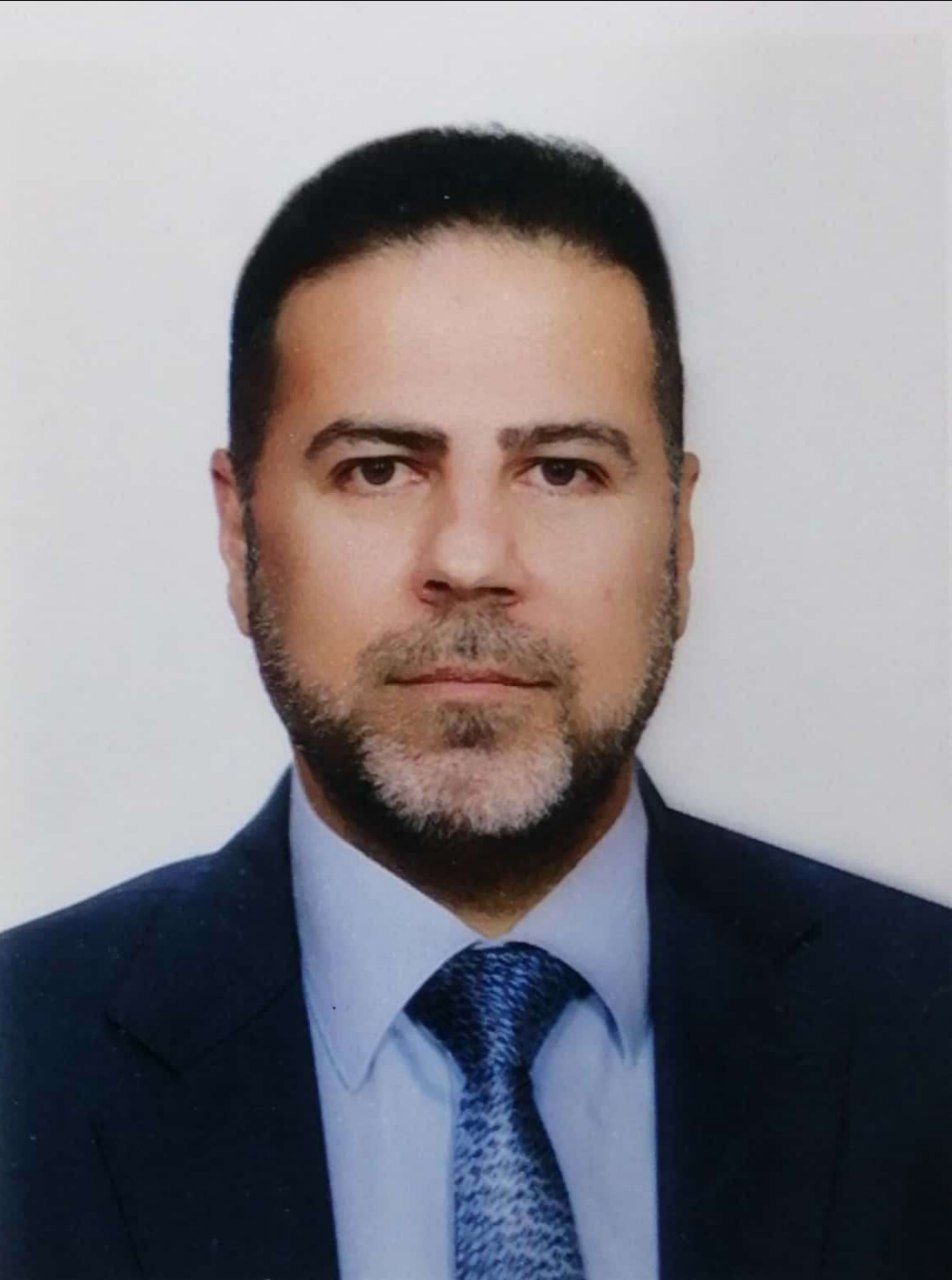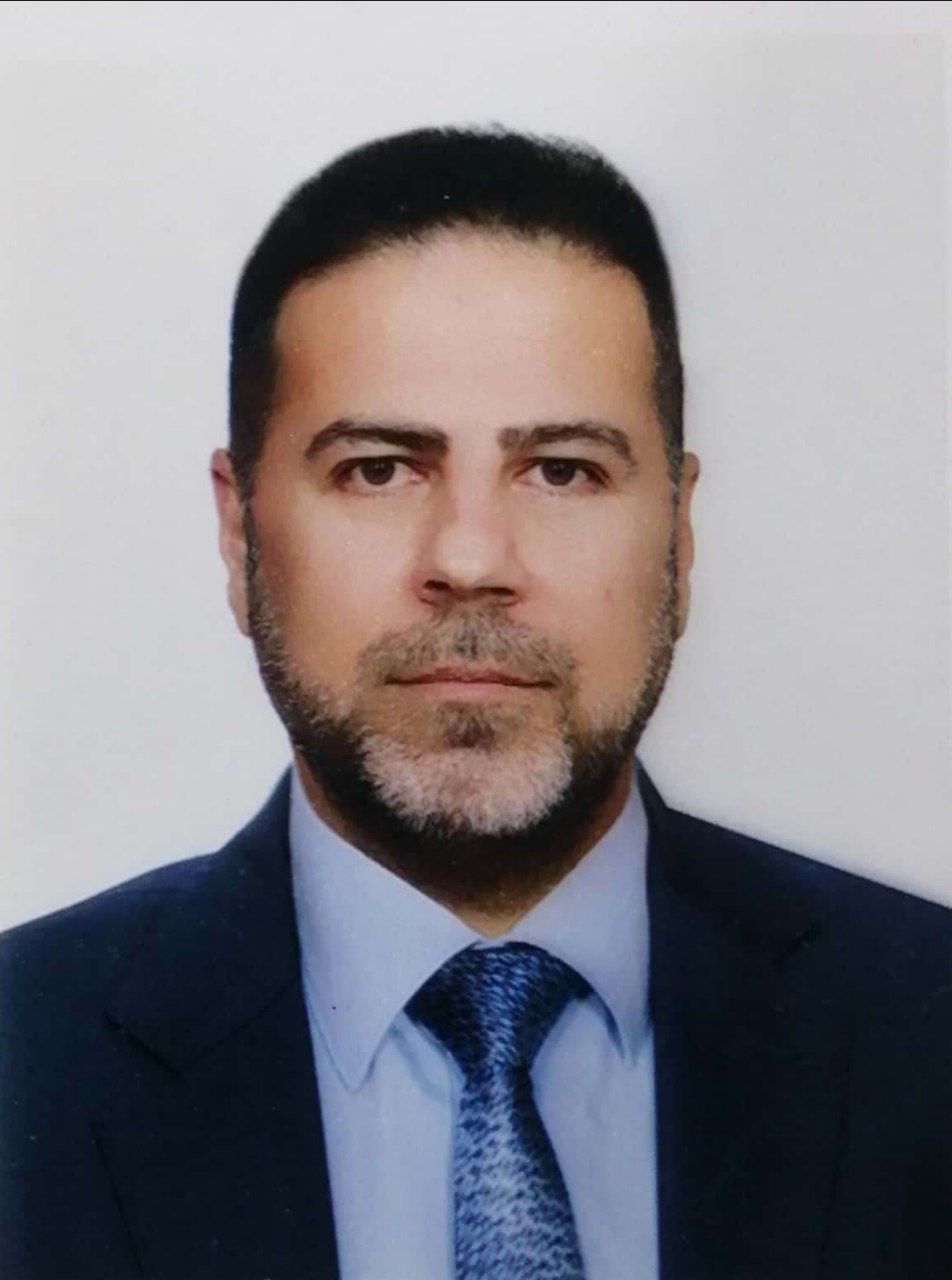
Firas Aziz Ali
Research InterestsRenewable energy
Nanofluid
Heat transfer
| Gender | MALE |
|---|---|
| Place of Work | Technical Engineering College/ Mosul |
| Position | Academic Lecturer |
| Qualification | Master |
| Speciality | power |
| firasaziz@ntu.edu.iq | |
| Phone | 07714410141 |
| Address | Al-Sedeeq avenue, Mosul, Mosul, Iraq |

First name: Firas Aziz
Surname: Ali
Birthday: 05/02/1975
Birthplace: Mosul city, Iraq
Bachelor project: Performance Prediction of Aircraft at Different Flight Conditions, Mechanical Engineering Department, University of Technology, Baghdad, Iraq, 1998.
Master thesis: Design Modeling and Performance Prediction of Air Intake for Different Flight Conditions, Mechanical Engineering Department, University of Technology, Baghdad, Iraq, 2004.
Specialization: Power.
The Last Scientific Position: Academic/Lecturer/(Assist prof.), Department of Power Mechanics Techniques Engineering, Northern Technical University, Mosul, Iraq, since 2005.
Research interests: Renewable energy, Nanofluids, Heat transfer
Scientific Publications: 12 Papers, 0 Books, 0 Patents, 8 Projects, 1 Thesis
Postgraduate Supervision Master's: 1 graduate student
Publications
Computation of Solar Radiation on Horizontal Surface Over Some Iraqi Cities
Jun 2, 2011Journal Engineering and Technology Journal
publisher University of Technology
DOI https://doi.org/10.30684/etj.29.10.14
Issue 10
Volume 29
In this study a simple correlation is developed to predict monthly average daily global solar radiation on a horizontal surfaces for different Iraqi locations. For fiveyears interval (1981-1985), monthly average daily global solar radiation and sunshine duration data were measured on horizontal surfaces at some Iraqi cities (Kirkuk, Baghdad, Nasiriyah). A mathematical linear correlation represented by (Angstrom correlation) was applied to estimate the global radiation from hours of sunshine duration for these cities at the specified day of each month as shown in tables (2a, b, c). The model was compared with three different mathematical correlations models (quadratic, logarithmic, and exponential) to get the best fit among them. The obtained models have a high value of regression coefficient and give best fit through the measured values. In this study, the monthly average daily diffuse and beam radiations on horizontal surface were estimated from the measured global radiation. The overall results show that, Baghdad city received higher radiation on the horizontal surface than Kirkuk and Nasiriyah.
Estimation the Effects of each site factors, time factors, and optical factors on absorbed solar radiation value that incident on a flat plate solar collector
Jul 31, 2012Journal Journal of Theoretical and Applied Information Technology
publisher Little Lion Scientific
Issue 2
Volume 41
In this paper, an estimated of absorbed solar radiation was developed to determine the performance of the solar collectors to develop best thermal energy conversion system. The aim of this research is to develop a tool for predicting the performance of a flat-plate solar collector from knowledge the absorbed solar radiation quantity. Also, the factors that affects on absorbed solar radiation value have been considered. These factors represented with collector tilt angle, the season changes that represented with month of year that the global solar radiation on horizontal surface has been measured, the location from the world represented with the latitude, time interval represented with hours of daylight from sunrise to sunset. Another optical factors affect on intensity of absorbed solar radiation has been considered. These factors correlated with absorptivity and transmissivity of the transparent glass cover which represented with (type, thickness, and number of glass covers). The result of each factor was analyzed for different collector tilt angle, latitude of place, and solar hour angle.
Evaluation of the Best Slope Angle for a Flat-Plate Solar Collector
Sep 22, 2017Journal Kirkuk Journal of Science (Kirkuk J. Sci.)
publisher University of Kirkuk
DOI 10.32894/kujss.2017.132393
Issue 4
Volume 12
The performance of flat plate solar collector is affected by the value of its slope angle with respect to horizontal plane, where the variation of slope angle changes the amount of incident solar radiation. So, using the solar tracking system for solar collector will get the maximum solar radiation, the application of the solar tracking system cost has high operation and maintenance. It is usually suitable to set the solar collector at a best fixed slope angle throughout the year with less reduction in solar radiation received on the collector surface. In this work, a best slope angles were calculated for solar collectors based on the monthly mean daily solar radiations on a horizontal surface over some Iraqi cities (Mosul, Rutba, and Basra). The total of rays flux incident upon a solar collector is mainly affected by the installation angle. The solar collector can be oriented at three different angle settings. The first angle setting is to adjust the collector monthly off to give highest incident solar radiation, while the second angle setting suggests the seasonally changes (Winter, Spring, Summer, Autumn) .The final adjustment for solar collector can be achieved using the mean value for the four seasons to get yearly averaged throughout the year.
Optimum Tilt Angle of Photovoltaic Panels for Some Iraq Cities
Jul 30, 2018Journal Journal of University of Babylon for Engineering Sciences (JUBES)
publisher Babil Al-Hilla: University of Babylon
Issue 1
Volume 26
The operation of a photovoltaic (PV) panels are influenced by its inclination angle with the horizontal surface. Thus, it must be inclined at a proper angle to raise the effectiveness of these panels. This research focuses on the computation of optimum slope angle of the PV panels in order to get the maximum incident solar radiation. Therefore, it is recommended to set the PV panels at fixed slope angle throughout the year to avoid the cost of sun tracking systems. In this research, an optimum slope angle of PV panels is investigated to get a maximum incident solar irradiance value using Bernard-Menguy-Schwartz model for some Iraq cities: Baghdad city (latitude of 33o22'N), Mosul city (latitude of 36o15'N), Zakho city (latitude of 37o10'N), and Samawah city (latitude of 31o15'N). The results showed that the optimum slope angle for these panels seems to be close to latitude of these cities.
An experimental investigation of a double pass solar air heater performance: A comparison between natural and forced air circulation processes
Nov 15, 2019Journal Solar Energy
publisher Elsevier
DOI https://doi.org/10.1016/j.solener.2019.09.060
Volume 193
This work involves an experimental study on a trapezoidal Double-Pass Solar Air Heater (DPSAH) to analyse its performance under natural and forced convection cases for the purpose of comparison. The experiments have been conducted in winter and compared for each case in same time and weather conditions. The collector has been carefully designed and constructed to prevent as possible the heat losses. A uniform fins have been fixed on both sides of the absorber plate to enhance the heat exchange rate. Effects of solar radiation and air mass flowrate on DPSAH performance have been investigated. The results show that DPSAH produces higher efficiency when the system is operated under natural convection case in comparison to forced convection case. The maximum efficiency has been found equal to 73.5% and 65% for natural and forced convection, respectively. A significant temperature difference has been obtained under natural convection case compared to forced convection. The results confirmed that DPSAH with adding fins leads to considerable performance improvement compared to conventional DPSAH due to enhance the absorbing solar energy caused by increasing surface area. The increasing in air mass flowrate has inverse influence on the performance of DPSAH. For natural circulation case, the outlet, plate and glass temperatures have been always observed higher than the forced convection case. It is evident that type of heat transfer has considerably affect the system performance and consequently, the selection of air circulation process are required to be satisfactorily chosen according to the application to achieve the desired objective.
Experimental study of compound parabolic concentrator with flat plate receiver
Feb 5, 2020Journal Applied Thermal Engineering
publisher Elsevier
DOI 10.1016/j.applthermaleng.2019.114678
Volume 166
In this paper, an experimental work has been performed to investigate the performance of a new Compound Parabolic Concentrator (CPC) with a flat plate receiver model. The CPC structure has been designed based on the two offset large parabolas reflector surfaces with a concentration ratio equal to 1.5. The experiments have been carried out in winter 2019 from beginning of January to end of March using the solar radiation of Mosul city in Iraq under outdoor clear sky condition for around 8 h during the day. The experimental results indicate that the increase in water mass flowrates enhances the efficiency of the collector and reduces the outlet water temperature. The results show that the change in months from January to March has little impact on the total solar radiation. The maximum solar radiation has been recorded in March and the peak value has been observed between 12 PM and 1 PM. The results also indicate that the CPC provides a maximum efficiency 26.5% and hence, sufficient consideration should be taken while designing such CPC collectors. It is evident that CPC area has significantly effect on the collector performance. The present study provides a useful tools for calculating the efficiency of CPC for Mosul city.
The impact of alumina nanoparticles suspended in ethylene glycol on the performance efficiency of a double pipe heat exchanger
Dec 25, 2020Journal Frontiers in Heat and Mass Transfer
publisher Tech Science Press
DOI https://doi.org/10.5098/hmt.15.21
Issue 1
Volume 15
The augmentation of the heat transfer in heat exchangers is one of the methods to increase efficiency of the system. The double tube heat exchanger is selected to many suitable techniques of heat transfer enhancement. In this study; the friction factor and heat transfer coefficient of double tube is evaluated experimentally. The Al2O3 nanoparticles dispersed in ethylene glycol (EG) with a diameter 50 nm and the weight concentration (0.1%, 0.3%, 0.5%, 0.7%, 1%) has been utilized. Then the effect of parallel current and counter current with different ranges of Reynolds number (10,000 to 30,000) on the friction factor and heat transfer coefficient experimentally examined then selected the best current flow. Thermophysical properties (density, viscosity) are measured and validated with experimental data of the other researches. Result showed that the friction factor decreases with increasing of Reynolds number and increases with increasing of weight concentration but Nusselt number increases with increasing of Reynolds number and concentration of weight. It was concluded that the utilizing of alumina nanoparticles suspended in EG through a double pipe heat exchanger is significant enhancement of heat transfer. The results indicate that the alumina dispersed in EG nanofluid can enhance thermophysical properties of EG to 20%. Likewise, the friction factor is slightly higher than that of pure EG and the nanofluid heat transfer is higher than the pure EG.
Performance analysis of Pelton turbine under different operating conditions: An experimental study
Feb 6, 2022Journal Ain Shams Engineering Journal
publisher Ain Shams University
DOI https://doi.org/10.1016/j.asej.2021.101684
Issue 4
Volume 13
In this article, an experimental work has been carried out to examine the effect of varying operating conditions on performance of Pelton turbine. The experiments have been performed for various nozzle jet diameters (d), volume flowrate (Q) and pressure head (H). The experimental results display that the rise in d leads to reduce the input power due to decrease in H. For a certain nozzle diameter, the results indicated that the maximum brake power increases with increasing in Q owing to increase the torque and consequently, the optimum operational condition can be achieved when using smaller d and higher Q. The best turbine performance has been found when using d = 9.5 mm and Q = 85 L/min owing to produce higher efficiency and cover large range of wheel speed. The maximum efficiency of nozzle diameters 9.5 mm, 10.5 mm, 11.5 mm and 12.5 mm have been found equal 35.5%, 33%, 29.2% and 21.6%, respectively. Hence, d has inversely effect on the turbine performance. The data clearly also indicate that d and Q have substantially influences on the power that generated by turbine. By recognizing the effects of related parameters, it is now possible to generate a higher electric power in hydroelectric power plants that operated by using Pelton turbine.
EXPERIMENTAL COMPARISON OF THERMAL PERFORMANCE BETWEEN V-CORRUGATED AND FLAT PLATE SOLAR COLLECTORS
Mar 31, 2023Journal International Journal on Technical and Physical Problems of Engineering
publisher International Organization on 'Technical and Physical Problems of Engineering'
Issue 54
Volume 15
In this study, the performance of flat plate (FP) and V-corrugated plate (VCP) solar water collectors (SWCs) with double glassed have been evaluated experimentally for purposes of comparison. VCP and FP absorber plates have been well-designed and constructed individually to prevent heat losses. The surface area of each solar collector (SC) is 1.5 m2. The absorber plates are made from copper with water tubes of 12.75 mm diameter fixed above the absorber plate in multi U-shaped along with the absorber plate. The study was achieved in winter 2022 (beginning in January and ending in March) utilizing Mosul's solar irradiation in Iraq, in clear sky circumstances, for about 7 hours through the day. Both collectors were manufactured and investigated in winter (January to March) under the same water flowrate is 0.0165 kg/s and under the same weather conditions. The most sun irradiation was reported in March, with the peak occurring between 12 and 1 p.m. The results showed that average values of experimental efficiencies for three months (January, February, and March) for VCP and FP collectors at mid-day hours are equal to 50% and 44%, respectively. Also, the mean absolute percentage error (MAPE) of experimental efficiencies between FP and VCP collectors and other works in the literature review was 8.8% and 7%, respectively. The current research offers a valuable tool for calculating the efficiency of solar water collectors (SWCs) in Mosul, Iraq.
Friction Factor and Heat Transfer Enhancement of Hybrid Nanofluids in a Heated Circular Tube
Oct 31, 2023Journal International Journal of Heat and Technology
publisher International Organization on 'Technical and Physical Problems of Engineering'
DOI https://doi.org/10.18280/ijht.410530
Issue 5
Volume 41
This work investigates the potential of hybrid nanoparticles suspended in pure water to enhance the thermal performance of heat exchangers at minimal weight fractions. A hybrid nanofluid consisting of 50% ZnO and 50% Al2O3 nanoparticles dispersed in pure water at weight fractions of 0.1%, 0.3%, and 0.5% was prepared. An experimental rig, featuring a straight horizontal tube with a constant wall heat flux, was equipped with eight thermocouples positioned at the inlet, outlet, and along the tube's surface. The study focuses on the impact of the hybrid nanofluid on the friction factors and heat transfer coefficients within a Reynolds number range of 5000 to 20000. Observations indicate that the Nusselt number escalates with an increase in the Reynolds number through the horizontal tube, while the friction factor exhibits a converse relationship. The peak Nusselt number and friction factor were observed at a 5% mass fraction of the hybrid nanofluid. Specifically, enhancements in the Nusselt number were recorded at 9%, 11.8%, and 16.7% for the weight fractions of 0.1%, 0.3%, and 0.5% respectively. Additionally, the deviation in the friction factor was noted at 2.3%, 3.6%, and 4.1% in comparison to pure water. This study thus provides critical insights into the role of hybrid nanofluids in optimizing heat transfer in heat exchangers.
Comparative Analysis of Fuzzy Logic, PID, and FOPID Controllers in DC Microgrid Voltage Regulation for Power Plants: Integrating Renewable Energy Sources
Nov 30, 2024Journal Journal of Advanced Research in Applied Mechanics
publisher Semarak Ilmu Publishing
DOI https://doi.org/10.37934/aram.128.1.5061
Issue 1
Volume 128
The worldwide direction moving towards sustainable energy solutions requires more advanced control mechanisms within power systems, especially in DC microgrids that combine renewable energy sources like solar panels and wind turbines with conventional power setups. This paper addresses the necessary challenge of maintaining steady and efficient DC voltage control—important for the dependability and performance of power plants. Specifically, it looks at the efficiency of four different control strategies: classic PID (Proportional-Integral-Derivative) controllers, Fuzzy Logic Controllers (FLC), Fractional Order PID (FOPID) controllers, and a new mixed system that merges Fuzzy Logic with PID controllers in a Fuzzy-PI layout. Our approach utilizes a strict comparative analysis using MATLAB Simulink simulations, assessing each controller’s capacity to manage dynamic load shifts, adjust to the unpredictability of renewable energy inputs, and preserve strong voltage stability under various operational cases. The simulations are crafted to single out the most effective control strategy to boost efficiency and toughness in microgrid operations. This study adds substantially to the progress of control strategies in hybrid energy systems, offering important insights into the creation of more complex and reliable power management solutions. By evaluating the performance of these varied controllers, we aim to underline potential upgrades in control systems that could support better energy management in intricate grid setups, thereby encouraging the wider inclusion of renewable energy technologies into power grids.










